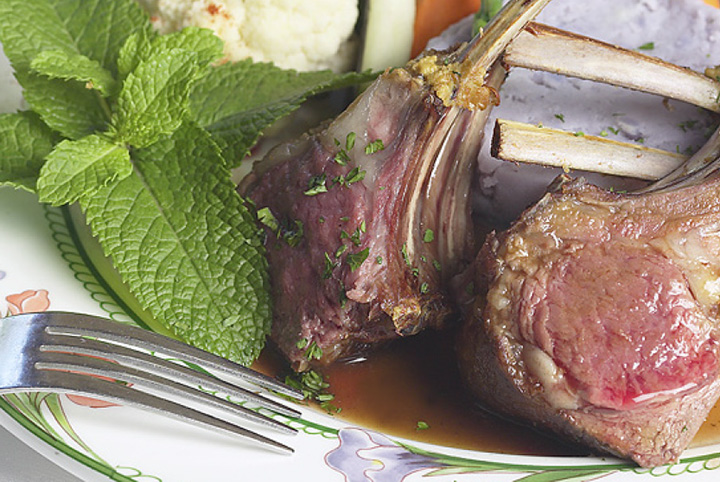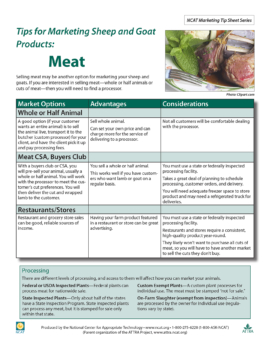Tips for Marketing Sheep and Goat Products: Meat
NCAT Marketing Tipsheet Series
By Margo Hale and Linda Coffey, NCAT
Selling meat may be another option for marketing your sheep and goats. If you are interested in selling meat—whole or half animals or cuts of meat—then you will need to find a processor.
Market Options |
Advantages |
Considerations |
| Whole or Half Animal | ||
| A good option (if your customer wants an entire animal) is to sell the animal live, transport it to the butcher (custom processor) for your client, and have the client pick it up and pay processing fees. | Sell whole animal.
Can set your own price and can charge more for the service of delivering to a processor. |
Not all customers will be comfortable dealing with the processor. |
| Meat CSA, Buyers Club | ||
| With a buyers club or CSA, you will pre-sell your animal, usually a whole or half animal. You will work with the processor to meet the customer’s cut preferences. You will then deliver the cut and wrapped lamb to the customer. | You sell a whole or half animal.
This works well if you have customers who want lamb or goat on a regular basis. |
You must use a state or federally inspected processing facility.
Takes a great deal of planning to schedule processing, customer orders, and delivery. You will need adequate freezer space to store product and may need a refrigerated truck for deliveries. |
| Restaurants/Stores | ||
| Restaurant and grocery store sales can be good, reliable sources of income. | Having your farm product featured in a restaurant or store can be great advertising. | You must use a state or federally inspected processing facility.
Restaurants and stores require a consistent, high-quality product year-round. They likely won’t want to purchase all cuts of meat, so you will have to have another market to sell the cuts they don’t buy. |
Processing
There are different levels of processing, and access to them will affect how you can market your animals.
Federal or USDA Inspected Plants—Federal plants can process meat for nationwide sale.
State Inspected Plants—Only about half of the states have a State Inspection Program. State inspected plants can process any meat, but it is stamped for sale only within that state.
Custom Exempt Plants—A custom plant processes for individual use. The meat must be stamped “not for sale.”
On-Farm Slaughter (exempt from inspection)—Animals are processed by the owner for individual use (regulations vary by state).
Market Options |
Advantages |
Considerations |
| Farmers Market | ||
| You can sell cuts of meat at a farmers market. | Farmers markets are great for marketing your product and meeting potential customers. | You must use a state or federally inspected processing facility.
Farmers markets can be very time-consuming. You must know the regulations on bringing meat to the market. Regulations, fees, insurance, and licenses vary, so be sure to check with the market director and local health department. Certain cuts of meat are likely to sell better than others. You may have to educate consumers on different cuts in order to sell all parts of the animal. |
| Value-added Products | ||
| You may work with your processor to develop value-added products from your meat, such as sausages or jerky. | Can use cuts of meat that typically don’t sell well to make these products. | Will take some time and resources to develop these products. |
How Much Meat Will I Get?
Only a portion of the animal’s live weight will be saleable meat. Knowing how much meat you can expect from your animals can help you with budgeting and setting a price for the animals/cuts of meat.
Dressing Percentage
Dressing percentage is the measurement of the carcass weight compared to the live animal weight. This includes the weight of the meat and bones, but not the hide or guts. There are many factors that affect the dressing percentage, but the average dressing percentage for lambs is about 55% and for goats it is a little less, around 50%.
- 100-pound lamb (live weight) x 55% dressing percentage = 55-pound carcass
- 60-pound goat (live weight) x 50% dressing percentage = 30-pound carcass
If you are selling cuts of meat, your 55-pound carcass doesn’t give you 55 pounds of cut meat. Many of the cuts will have fat trimmed from them and will be trimmed from the bone. For lambs, you can estimate that about 70% of the carcass will be saleable cuts, and for goats it will be closer to 60%.
- 100-pound lamb x 55% dressing percentage = 55-pound carcass x 70% = 38.5 pounds of meat cuts
- 60-pound goat x 50% dressing percentage = 30-pound carcass x 60% = 18 pounds of meat cuts
Resources
ATTRA – National Sustainable Agriculture Information Service
Marketing Out of the Mainstream
Maryland Small Ruminant Page—Marketing
Cornell University—Sheep & Goat Marketing
Marketing Meat Goats, the Basic System—Kentucky State University Cooperative Extension Program
Tips for Marketing Sheep and Goat Products: Meat
© 2012 National Center for Appropriate Technology—NCAT
By Margo Hale and Linda Coffey, NCAT
IP399
This publication is produced by the National Center for Appropriate Technology through the ATTRA Sustainable Agriculture program, under a cooperative agreement with USDA Rural Development. This publication was also made possible in part by funding from USDA/NIFA/OASDFR. ATTRA.NCAT.ORG.
Related Publications
- Meat Goats: Sustainable Production
- Tips for Marketing Sheep and Goat Products: Vegetation Management
- Tips for Marketing Sheep and Goat Products: Dairy
- Sheep and Goats: Frequently Asked Questions
- Tipsheet: Organic Cattle, Sheep, and Goats for Dairy
- Dairy Production on Pasture: An Introduction to Grass-Based and Seasonal Dairying



